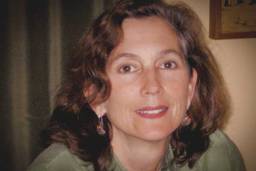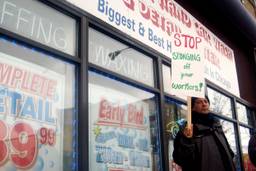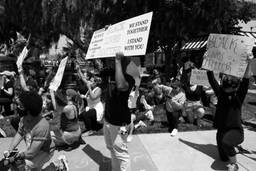Hull-House Museum: Open to the Counter-Public
The revolution lives at Jane Addams’ historic old house in Chicago.
Andrew Oxford

A century ago, Chicago’s near-west side was declared “unfit for human habitation” by Eugene V. Debs. Once crowded with industrial workers – mostly immigrants – who packed into squalid tenements, the neighborhood has long since been paved over by freeways and the sprawling campus of the University of Illinois at Chicago.
Standing on the front porch of the ornate nineteenth-century mansion that is the Jane Addams Hull-House Museum, it is difficult to imagine this Chicago of a century ago. Co-founded by Addams in 1889 as a settlement house, it would develop into a center for radical organizing on the city’s near-west side. The struggles for women’s suffrage, prison reform, workers’ rights and civil rights gave life to the community center, along with the 6,000 immigrants who visited it weekly. The mansion and adjoining dining hall, all that remain of their era, seem to defy contemporary surroundings.
That is exactly the point, according to the museum’s executive director, Lisa Lee. “We think not just about our own site, but about all the different sites throughout an urban landscape that have seen political struggles that should be preserved,” Lee says. “Not calcified, but preserved in a way that they can have a living meaning for people.” This approach “radically changes” what museums do, she adds.
The birthplace of an American brand of radicalism, the Hull-House re-opened in September after renovations for Addams’ 150th birthday that reinvent the museum not as a repository of artifacts to be passively consumed but a space where present-day reformers can interact with their own progressive heritage.
The events calendar is as varied today as it was a century ago. A soup kitchen in the dining hall where Debs, Gertrude Stein and W.E.B. DuBois once held meetings now hosts speakers on issues ranging from food access to nutrition and urban farming. Sex activists are curating an ongoing film series. A recent book reading on economic disobedience drew a mix of students and organizers. Juvenile justice reform advocates have been collaborating on a current exhibit that connects the history of the first juvenile court in the United States – campaigned for by Addams and her colleagues – with our contemporary flawed legal system.
In 1889, when Addams brought her formal education and affluence to her work in overcrowded immigrant neighborhoods, she relied on a common revolutionary spirit not merely to improve the city, but foster radical democracy.
In her bedroom, the Nobel Prize she received in 1931 is displayed alongside her bulging FBI file. “There’s not just one story about Jane Addams. She’s a Nobel Peace Prize winner, she’s a lesbian, she’s the most dangerous woman in America,” says Lee, referring to the title bestowed on her by FBI Director J. Edgar Hoover.
The museum does not shy away from the many dimensions of Addams, who appears in late portraits as a matronly educator surrounded by children. She spoke vehemently against World War I (helping to found the Women’s International League for Peace and Freedom in 1915) and collaborated with labor leaders.
While working with other activists, Addams emphasized the importance of marrying theory and practice. “[She] was really more of a theorist and a writer, always pairing herself with people like Ellen Gates Starr, who felt more comfortable protesting in the streets and getting arrested,” Lee notes. “But they realized that [working] together – that was how change took place.” (Full disclosure: Lee is a member of the In These Times Publishing Consortium.)
Working with a cadre of activists such as Dr. Alice Hamilton, Ida B. Wells, and Florence Kelley as well as academics like John Dewey, Addams brought a revolutionary pragmatism to Chicago’s near-west side and its own diverse constituencies. In its more than 60 years, Hull House offered kindergarten, vocational courses, daily meals, and support for innumerable community groups and activists. The stream of students and reformers who worked with Addams would go on to found the fields of social work and juvenile justice, thereby forging American progressivism.
“What she wanted to do,” says Lee, “was create a culture in which workers recognize they can be in solidarity to solve their problems, and also create an opportunity for exchange so they could see each other’s humanity in different lights.”
The museum staff has adopted John Berger’s famous quotation as a motto: “Never again shall a single story be told as if it is the only one.” While that may be particularly reflective of the community in which Addams worked, it should, Lee says, be true of cultural institutions everywhere.
“As a public institution the museum has provided a very good history of how one really addresses, creates and responds to public needs. And how we actually create a public that is truly radical and does not just exist to police the private,” Lee says.
By maintaining Addams’ home as a safe space for what the Frankfurt School termed the “counter-public” – populations typically excluded from power – Addams’ legacy is not relegated to history but instead remains in flux with the city she tried to revolutionize. Part of what makes the museum so relevant is its founder’s approach to community work. “When Addams got here, I think she had a very elitist and patrician notion of what culture was,” Lee says, a notion unfortunately still commonplace today. “She realized that culture was actually not something that exists de facto, but rather is created between the relationships you have with people. It’s a living, growing, expanding thing, and it’s through the creation of culture that you actually create the culture of democracy.”
Addams was considered a revolutionary in her own time but today is thought of as a great reformer. Lee believes she epitomizes both.
The Hull-House Museum tries to bridge the difference by creating a space for revolutionary ideas to grow. By joining the history of these ideas with their present-day radical manifestations, the museum concretely links reform and revolution.
The power of labels is a recurring theme at the Hull-House Museum. To confront Addams’ homosexuality, earlier this year the museum asked visitors to write down the label best describing themselves; thousands responded. The exercise encouraged people to place their presumptions in an historical context and triggered discussion about how contemporary modes of thought interpret history.
By placing history in the hands of visitors and applying Addams’ progressive vision to current struggles, theory is once again meeting practice at Hull House.








